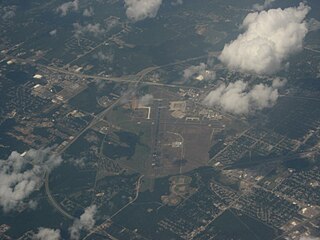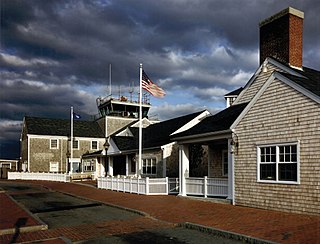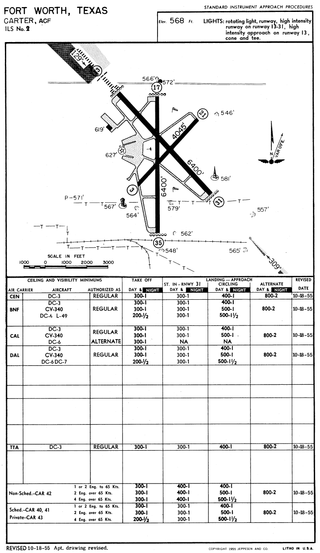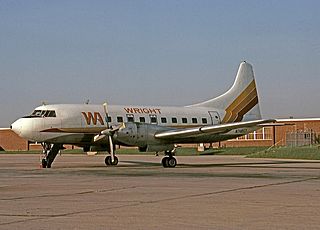
Long Island MacArthur Airport, formerly known as Islip Airport, is a public airport in Ronkonkoma, in the Town of Islip, in Suffolk County, on Long Island, New York, United States. Covering 1,311 acres (531 ha), the airport was established in 1942 and began serving as a commercial airport in 1960. It has three runways and two helipads.

El Paso International Airport is an international airport located four miles (6 km) northeast of downtown El Paso, in El Paso County, Texas, United States. It is the busiest commercial airport in West Texas, and also serves Southern New Mexico and Northern Mexico. It handled 3,904,110 passengers in 2023, with 96,316 aircraft operations.

Corpus Christi International Airport is 6 miles west of Corpus Christi, in Nueces County, Texas. It opened in 1960, replacing Cliff Maus airport at 27.767°N 97.44°W, where the Lozano Golf Center is now located.
Jack Brooks Regional Airport, formerly Southeast Texas Regional Airport, is near Port Arthur, Texas, nine miles (14 km) southeast of Beaumont and northeast of Port Arthur. It was Jefferson County Airport, but its name was changed to honor former U.S. Representative Jack Brooks. The airport is southwest of the city of Nederland in unincorporated Jefferson County, and is used for general aviation. Southwest Airlines ended scheduled jet service in 1980 and several other airlines have started and ended service as well including American Eagle, Continental, Delta/Delta Connection and United Express. The latest chapter is the resumption of service by American Eagle for American Airlines to Dallas/Ft. Worth (DFW).

Las Américas International Airport is an international airport located in Punta Caucedo, near Santo Domingo and Boca Chica in the Dominican Republic. The airport is run by Aeropuertos Dominicanos Siglo XXI (AERODOM), a private corporation based in the Dominican Republic, under a 25-year concession to build, operate, and transfer (BOT) six of the country's airports. Las Américas usually receives a wide variety of long-, mid-, and short-haul aircraft. Santo Domingo's other airport, La Isabela, is much smaller and used by smaller aircraft only.

Waterloo Regional Airport ( Livingston Betsworth Field) is four miles (6 km) northwest of Waterloo, in Black Hawk County, Iowa. It is used for general aviation and sees one airline.

Cape Cod Gateway Airport, also known as Boardman/Polando Field and formerly known as Barnstable Municipal Airport, is a public airport located on Cape Cod, one mile (1.6 km) north of the central business district of Hyannis, in Barnstable County, Massachusetts, United States. This airport is publicly owned by the Town of Barnstable. It is Cape Cod's major airport as well as an air hub for the Cape and the Islands. The airport is served by scheduled commercial flights as well as charters and general aviation. Barnstable Municipal Airport served as a hub for Nantucket-based commuter airline Island Airlines until its shutdown in 2015.

Worcester Regional Airport is three miles (5 km) west of Worcester, in Worcester County, Massachusetts, United States. The main property lies within municipalities of Worcester and Leicester, with supporting facilities in Paxton. Once owned by the City of Worcester, the airport has been owned and operated by the Massachusetts Port Authority (Massport) since June 2010.

Grand Junction Regional Airport is three miles (4.8 km) northeast of Grand Junction, in Mesa County, Colorado, United States. Owned by the Grand Junction Regional Airport Authority, it is the largest airport in western Colorado and third largest in the state, behind Denver International Airport and Colorado Springs Airport.

Juneau International Airport is a city-owned, public-use airport and seaplane base located seven nautical miles northwest of the central business district of Juneau, a city and borough in the U.S. state of Alaska that has no direct road access to the outside world. The airport serves as a regional hub for all air travel, from bush carriers to major U.S. air carriers such as Alaska Airlines.

Shreveport Regional Airport is a public use airport in Shreveport, Louisiana, United States. It is owned by the City of Shreveport and located four nautical miles (7 km) southwest of its central business district.

Nantucket Memorial Airport is a public airport on the south side of the island of Nantucket, Massachusetts, United States. It is owned by the Town of Nantucket and is located three miles (5 km) southeast of the town center. It is the second-busiest airport in the state, after Logan International Airport, due to intense corporate travel to and from the island in the high season.

Daytona Beach International Airport is a county-owned airport located three miles (5 km) southwest of Daytona Beach, next to Daytona International Speedway, in Volusia County, Florida, United States. The airport has 3 runways, a six-gate domestic terminal, and an international terminal. Daytona Beach is the headquarters of Embry-Riddle Aeronautical University.

Greater Southwest International Airport, originally Amon Carter Field (ACF), was the commercial airport serving Fort Worth, Texas, from 1953 until 1974. Dallas/Fort Worth International Airport opened in 1974 a few miles north to replace Greater Southwest and Dallas Love Field as a single airport for the Dallas-Fort Worth Metroplex. The area is now a commercial/light-industrial park serving DFW International, centered along Amon Carter Boulevard, which follows the old north-south runway.

Manchester–Boston Regional Airport, commonly referred to as Manchester Airport, is a public use airport 3 miles (5 km) south of the central business district of Manchester, New Hampshire, United States on the border of Hillsborough and Rockingham counties. It is owned by the City of Manchester, and is in the southern part of the city on the border with Londonderry, New Hampshire.

Air New England (ANE) was a US regional airline in New England during the 1970s and early 1980s. It was headquartered at Logan International Airport in the East Boston area of Boston, Massachusetts. ANE was noneconomic for most of its existence. From 1975 through its last year, 1981, ANE depended heavily on government subsidies. Depending on the year, these accounted for 17 to 25% of operating revenues, despite which the airline was generally unprofitable. ANE collapsed in the early years of US airline deregulation.

Trans Caribbean Airways (TCA) was an irregular air carrier until 1957, when it was certificated by the Civil Aeronautics Board (CAB) as an international air carrier to fly from New York City to San Juan, Puerto Rico. TCA thereafter operated as a small scheduled airline specializing in flying from New York to the Caribbean, adding a small number of additional routes over time until it was purchased by American Airlines in 1971.

On the surface, Wright Air Lines was no different than many other many other small turboprop airlines that collapsed in the early years of the deregulated US airline industry. What set Wright apart was:

Dillant–Hopkins Airport is a general aviation airport located 2 miles (3.2 km) south of the central business district (CBD) of Keene, in Cheshire County, New Hampshire, United States. It covers 888 acres (359 ha) and has two runways. It is included in the Federal Aviation Administration (FAA) National Plan of Integrated Airport Systems for 2017–2021, in which it is categorized as a regional general aviation facility.

Portland International Jetport is a public airport two miles (3 km) west of downtown Portland, Maine, United States. It is owned and operated by the City of Portland. A portion of the Jetport's property, including the main runway, is located within the neighboring city of South Portland. PWM covers 726 acres of land.






















